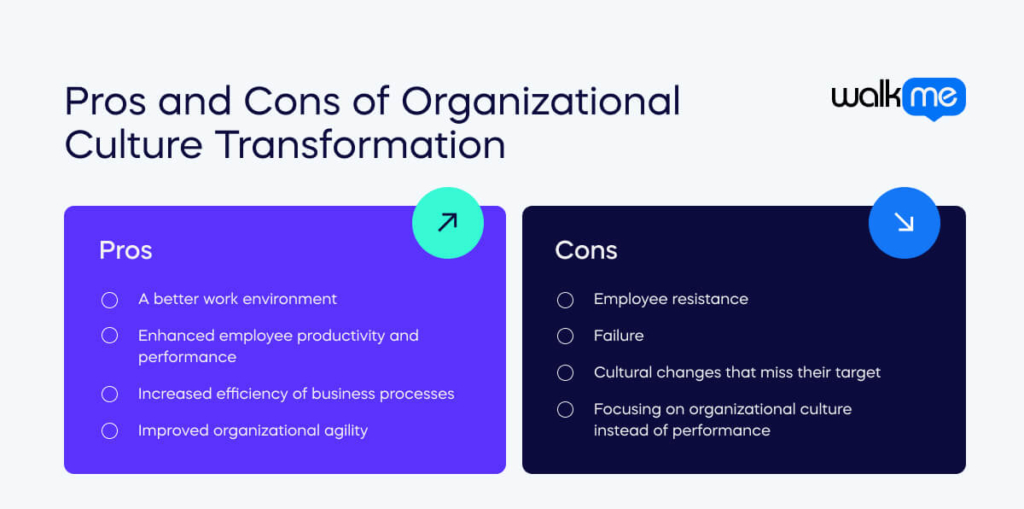In this article, we’ll look at the pros and cons of organizational culture transformation.
Organizational culture – the workforce’s set of shared values, beliefs, and assumptions – plays a large role in organizational effectiveness and performance.
Today, organizational culture has become a topic of interest for many business professionals.
And there are good reasons for this.
After all, culture affects many areas of the business, such as:
- Employee productivity and performance
- An organization’s overall performance in its industry and marketplace
- An organization’s ability to change successfully
However, cultural transformations are not easy and they are not always advisable.
Below, we will look at organizational culture transformations in detail, including:
- The pros and cons of transforming an organization’s culture
- When a business should transform its culture … and when it shouldn’t
- Tips for successfully changing a culture
To start with, however, we should first explain what organizational culture is and why businesses might want to change it.
Organizational Culture 101
A business’s culture, as mentioned, is the company’s shared set of beliefs, values, and assumptions.
Cultures play a large role in how workers behave, the social environment of the workplace, worker performance, and so forth.
In some cases, culture can have a positive impact on organizational performance.
In others, the impact can be negative.
Today, for instance, many of the following types of cultures are considered desirable:
- Customer experience cultures
- Data-driven cultures
- Digital cultures
- Cultures that are innovative, adaptable, and open to change
- Cultures that value employee learning
Such company cultures can help businesses succeed, because the workforce is more creative, productive, and willing to learn.
However, cultural change comes at a price, and it is not always the right path to take.
Pros and Cons of Organizational Culture Transformation

Before embarking on any organizational culture transformation, it pays to be aware of the positives and negatives of cultural change.
The pros of culture change can include:
- A better work environment. The right culture can improve employees’ day-to-day interactions and help create a smoother, more streamlined workplace.
- Enhanced employee productivity and performance. Certain cultural traits can increase productivity and performance, such as a focus on learning or digital dexterity.
- Increased efficiency of business processes. Because culture fuels the entire organization, individual performance gains translate into gains across the entire business.
- Improved organizational agility. When employees value adaptability, for instance, the organization itself will be better suited to continual change and adaptation.
However, there can be downsides to cultural change, which should be addressed early on to prevent problems.
Cons of culture transformation can include:
- Employee resistance. Cultures rest upon deep-seated beliefs and values – changing those can create friction and cause employees to resist change.
- Failure. In worst case scenarios, attempting to inculcate new values into a workforce can backfire and result in failure.
- Cultural changes that miss their target. Cultural changes should be aimed at specific objectives, such as increasing performance. However, miscalculations can end up having no effect or even the opposite of the intended effect.
- Focusing on organizational culture instead of performance. Organizational culture changes are typically designed to enhance organizational performance, organizational transformation, or other objectives. However, too much emphasis on the culture can distract from those objectives.
Both the pros and cons of a culture change should be considered carefully before implementing a cultural change program.
When to Transform Culture … And When Not To
Is it the right time to transform your company culture?
To answer that question, it pays to understand the motives behind it.
A cultural change program, as mentioned, should support strategic objectives, such as organizational performance or organizational transformation projects.
It may be a good idea to initiate cultural change if…
- The proposed culture change would support another program, such as an organizational change project or an organizational transformation effort
- The current company culture would hinder such a project
- The costs of cultural change would not outweigh the benefits
- Culture shifts don’t take precedence over the primary aims
When these criteria are met, then cultural change could offer benefits.
However, if culture becomes the main focus … and doesn’t add value to the bottom line of a business … then the costs may outweigh the potential returns.
How to Execute Organizational Culture Transformation
Executing organizational culture changes takes time, effort, and planning.
Here are a few tips for getting it right:
- Assess the current culture, through interviews, surveys, and two-way communication
- Assess the benefits and drawbacks of adjusting the culture, then compare those to the benefits and drawbacks of doing nothing
- If cultural change looks like a good plan, then draw up a proposal that outlines the intended changes along with the intended benefits
- Obtain executive sponsorship and, ideally, leadership
- Develop a change management plan and a communications strategy built around the new vision of the company’s culture
- Dismantle the existing culture and build the new one through team restructuring, a change story, change management frameworks, and other change management tools
- Measure, analyze, and continually improve the change program
Again, cultural change projects are investments that take time and effort.
To maximize the chances of success, continually monitor feedback, track metrics, and measure KPIs.
Don’t be afraid to adjust your own approach if necessary.
After all, like any other organizational change project, cultural change projects should be relevant, agile, and adaptable.

